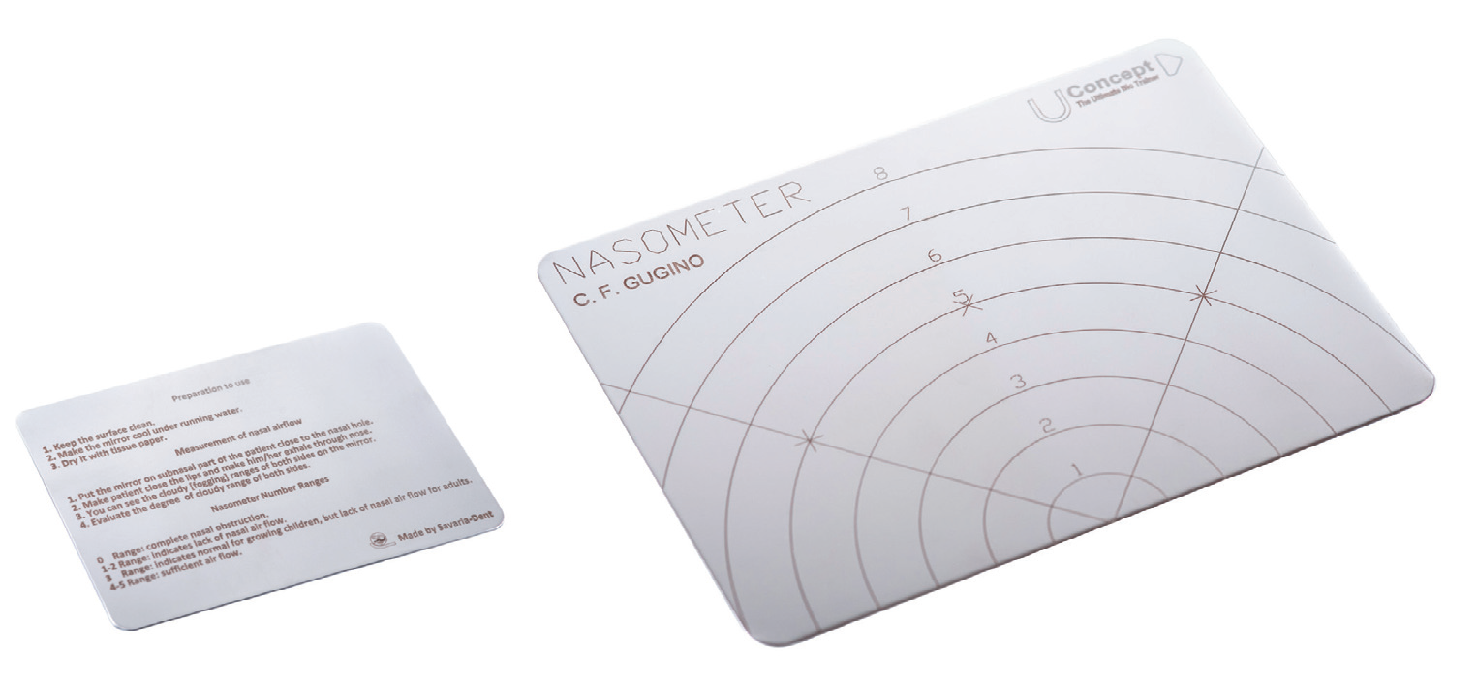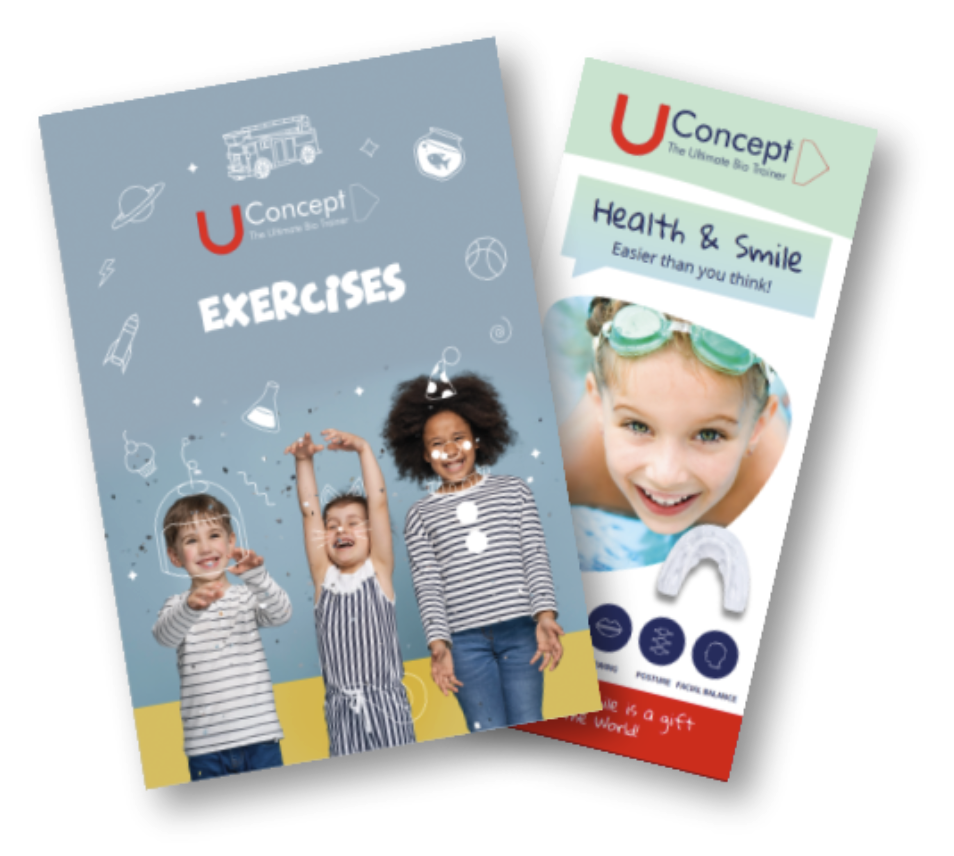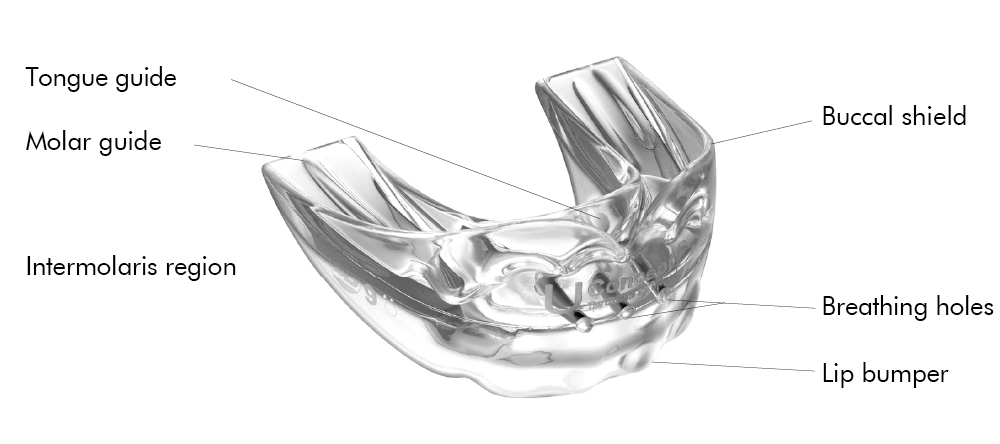U Concept
What is the trainer?
Trainers are effective aids for the optimal dental development during the growth phase of childhood. Due to their positive effects, an increasing number of professionals (e.g. dentists, speech therapists) recommend their use, starting as early as 3 or 4 years of age. Regular wearing of them results in spectacular improvement in most young patients.
Their mechanism of action is dominated by two main factors:
- on one hand the myofunctional education
- on the other hand, the stimulation of the harmonic development of the dental arches
Why is U Concept different?
- Because we have designed a product family, where we kept the „passive” myofunctional therapy approach at the dental arch level, but developed an active training appliance family on the dental level, so the U Concept trainers, are active trainers. This means, that the dental arch harmonization process is more intensive, the softer, more flexible devices are supporting the arch levelling with lighter forces, yet with greater effectivity, of course while they are also maintaining the functions expected from other standard trainers. The wider front part – “U” shape – (“Accu form”) leaves the treating doctor a better chance of avoiding extraction during subsequent orthodontic treatment.
- In the area of the front teeth, torque values help to ensure optimal positioning of the teeth. The vacuum effect created makes it easier for the appliance to remain in the mouth. Certain elements of the appliance family – U Class III – also help the development of the premaxilla.
- The guide slots along the lateral zone aid to harmonize the dental arches. To help the harmonization, we included a ridge (guide strip) along each side, which fits into the longitudinal groove of the molars assisting their alignment.
- In accordance with the age groups, our appliances are longer in the distal direction than other manufacturers' trainer appliances, thereby supporting the molars that are currently erupting, thus avoiding "hanging" cusps or over-erupted teeth. If the appliance is excessively long, the solution is simple, it can be easily cut to size with scissors.
- The special design of the front area prevents the trainer from getting behind the child's upper dental arch.
- Several options are available for the thickness of the progressive inter-molar region between molars and premolars.
- The devices can be easily customized with the help of a pair of scissors.
- To make the trainers easy to adjust to, comfort is a fundamental feature of all our U Concept appliances. We manufacture the devices in two types of silicone, 30 and 50 Shore hardness. The softer 30 Shore hardness version provides greater comfort and is easier to adapt to, which is key to success, as the trainers are effective only with regular use. The 50 Shore hardness version is more resistant to stress-induced teeth clenching, so children chew the device more slowly.
- We manufacture the entire product line using biocompatible silicone.
- Our devices are available in multiple colours, helping to maintain patient motivation.
Functional therapy
What does myofunctional therapy mean?
Angle identified overactive or underactive soft tissue functions, pressures, and breathing issues as the root causes of malocclusions as early as the beginning of the 20th century. In 1918, Alfred Rogers, the father of myofunctional therapy, further developed this theory. He emphasized the need for specific exercises to establish proper functions.
Since then, many exceptional orthodontists have embraced functional treatment. Professor Slavicek examined the entire body, from the patient's feet to the top of their head, and identified a network of connections. Among orthodontic specialists, Professor Rickets is a prominent figure known for laying the foundations of the bioprogressive technique and developing its treatment methods. He taught and regularly applied myofunctional therapy at the school named after him. The core principle is that a patient's dysfunctions should be assessed as early as possible—ideally in early childhood—and addressed through various exercises to ensure that growth continues in the right direction.
For hundreds of years, various devices and therapies have been utilized to correct dental and jaw issues. In the late 19th and early 20th centuries, the field of orthodontics was formally established within dentistry, alongside advancements in dental technology that led to the creation of specialized laboratories for orthodontics. These laboratories primarily produced removable devices tailored to each patient’s plaster model, mostly made from hard acrylic. These devices were typically secured to the teeth with wire clips and primarily facilitated dental movement. Among them were activators, which aimed to harmonize the dental arches. When worn regularly, these devices could yield significant results. However, they did not incorporate myofunctional practices.
In the 1990s, a new approach to functional training began to take shape. Dr. Chris Farrell developed a family of devices made from softer, more flexible materials, which he called "trainers." Drawing on his accumulated experience, he designed an increasing number of devices, a development that continues today. He established an effective protocol for performing the exercises, emphasizing the importance of both motivation and controllability. The devices he created allow for a significant degree of freedom for the teeth. The primary function of his trainers is to re-educate various dysfunctions—such as mouth breathing, tongue thrust swallowing, thumb sucking, and other bad habits—while also strengthening underdeveloped muscles.
Practitioners of bioprogressive therapy also recognized the benefits of trainers. Under the guidance of Dr. Daniel Rollet, they developed specialized trainers—such as the RMO "Multi" family, the Orthoplus "EF" family, and products from the LM company—to better align with their therapeutic goals based on functional education.
In our opinion, it can generally be stated that these devices allow the teeth too much freedom.
The U Concept product encompasses a holistic perspective, that consists of:
- the U Concept product line,
- complementary exercise system supporting functional education
- continuous multi-directional development
- and of education
U Concept product line
When designing the first devices – from 2012 – and setting the direction, it was of great help to us that we manufactured 10-15,000 removable orthodontic appliances per year in our orthodontic lab, which had been operating for 30 years at the time. Based on the experience we gained in this way, led us to believe that the trainers already on the market could be made much more effective by incorporating additional dental functions and creating so-called “active/interactive” devices. The idea was also supported by Dr. Daniel Rollet, with his active participation we began manufacturing the first pieces. In the further development of the devices, we combined the guidelines of Dr. Carl Gugino, who was still an active member of the old Rickets team, with the possibilities offered by new manufacturing technologies and our own experiences.
The U Concept core product line consists of:
- U Kiddy
- U Start
- U Trainer Soft
- U Trainer
- U Class II
- and U Class III devices, as well as the size variations of these
The complete product line includes the U Pilot series (available in seven sizes, the selection of the correct size is assisted by a 7 seven-piece Size Selector series), the U Brace which can be combined with fixed devices, and the U Class II Pre for cases with an overjet greater than 8-9mm. Our devices were primarily developed for Caucasian facial characteristics, but we also offer options for Asian facial structures with wider jawbones. We believe that our product line provides solutions for most potential issues. We consider it important to remain open to experiences and ideas that can enhance the effectiveness of functional therapy, and we are receptive to designing new appliances.
As part of the development process, we created the Gugino-inspired Nasometer. As we know, mouth breathing is one of the primary causes of dental deformities; therefore, the ability to breathe through the nose is crucial. This capability can be easily assessed using this device.

An indispensable component of the U Concept is the system of myofunctional exercises. An exercise book was created as an aid to facilitate the selection and demonstration of the appropriate exercises.

Education is our passion. We provide participants with essential knowledge through both domestic and international venues, offering courses that are available online or in person. Participants gain valuable insights on topics that simplify everyday life, including effective communication strategies with patients and teaching assistants, as well as methods for presenting delegation options and managing control processes.
The team behind U Concept tirelessly works on developing trainers that provide effective, comfortable, and successful results, ensuring comprehensive service. We never lose sight of the fact that at the end of the device is a person—generally a child—whose healthy development depends on us.
Parts of the device
The devices feature specially designed elements that positively influence the development of soft tissue and muscles:
- assisting in guiding the tongue to the correct position
- training the labial muscles
-
Promoting the correct placement of permanent teeth during the dental transition.

- Adaptable buccal shield: Positioned in front of the dental arches, it extends over the teeth and keeps the buccal tissues away from the dental arch, thus minimizing external compressive forces acting on the arch. Furthermore, by gently stretching the periosteum, it encourages additional bone growth on the buccal side of the alveolus, leading to an increase in the size of the dental arches. The buccal shield can be modified as necessary.
- Intermolar region, and molar guide: This is the thickened intermolar bite plane with a triangular slope. The molar guide fits into the grooves of the molars, aiding in the proper positioning of the emerging premolars and molars. The anterior design, together with the reinforced molar section, ensures that the lower jaw is in edge bite, while also lifting out and moving the condyle downward, thereby promoting the growth of the lower jawbone (with the exception of Class III devices). The appliances should extend at least halfway to the last tooth. If they are too long, they can be easily adjusted with scissors.
- Tongue guide: The design of the appliance on the tongue side assists guiding the tongue to the correct position. When the tongue rests on the palate, it provides support to the alveolar arch of the maxilla from within, thereby preventing the frequent stenosis of the upper dental arch or aiding in the resolution of existing stenosis.
- Tongue reminder: Assists in teaching and maintaining the proper position of the tongue.
- Lip bumper: This section of the buccal shield is located in front of the lower anterior teeth and is designed to alleviate excessive tension from the lower lip. By reducing the pressure exerted by the lower lip, it helps to prevent the onset or exacerbation of crowding in the lower front teeth. This feature is particularly beneficial in cases where the lower lip becomes trapped behind the upper front teeth (Class II/I).
- Breathing holes: The small openings at the front of the appliance help to decrease the vacuum formed during swallowing, making the adaptation phase easier.
General characteristics of the devices:
The devices are made of sterilizable, biocompatible odourless silicone with Shore hardness of 30 and 50. Due to their softness, the Shore 30 appliances are very comfortable to wear, which facilitates the adjustment period. However, because of their soft properties, they are more susceptible to damage from improper use, such as chewing, compared to the Shore 50 devices. According to the recommended protocol, treatment should begin with the Shore 30 appliances, and if necessary (due to frequent damage from chewing), the treatment can be switched to a Shore 50 device.
Join us!
For further information about the U Concept Bio Trainers, we offer lectures and webinars tailored for orthodontists, speech therapists, therapists, and healthcare professionals. To stay updated, please follow our event calendar. If you’d like to expand your therapeutic toolbox and enhance the effectiveness of your therapy, consider trying the Bio Trainer!
By joining our healthcare professional search engine, your patients will be able to find you more easily and quickly. Simply fill out your contact details to get started.
